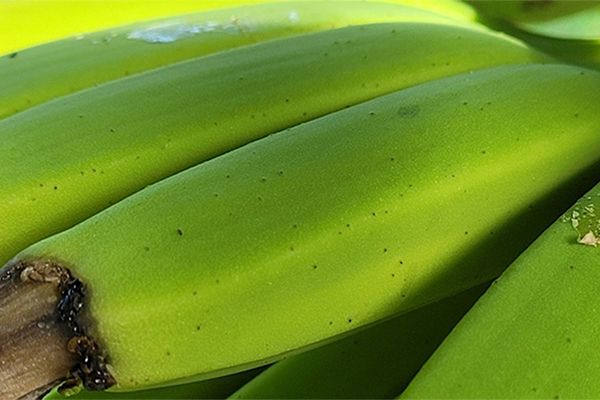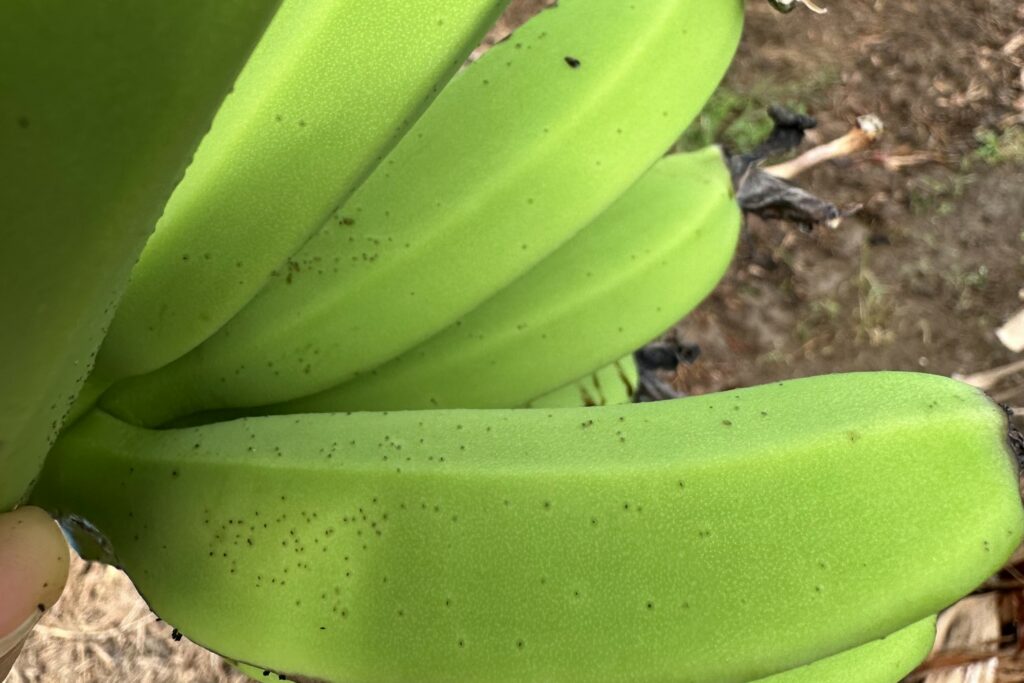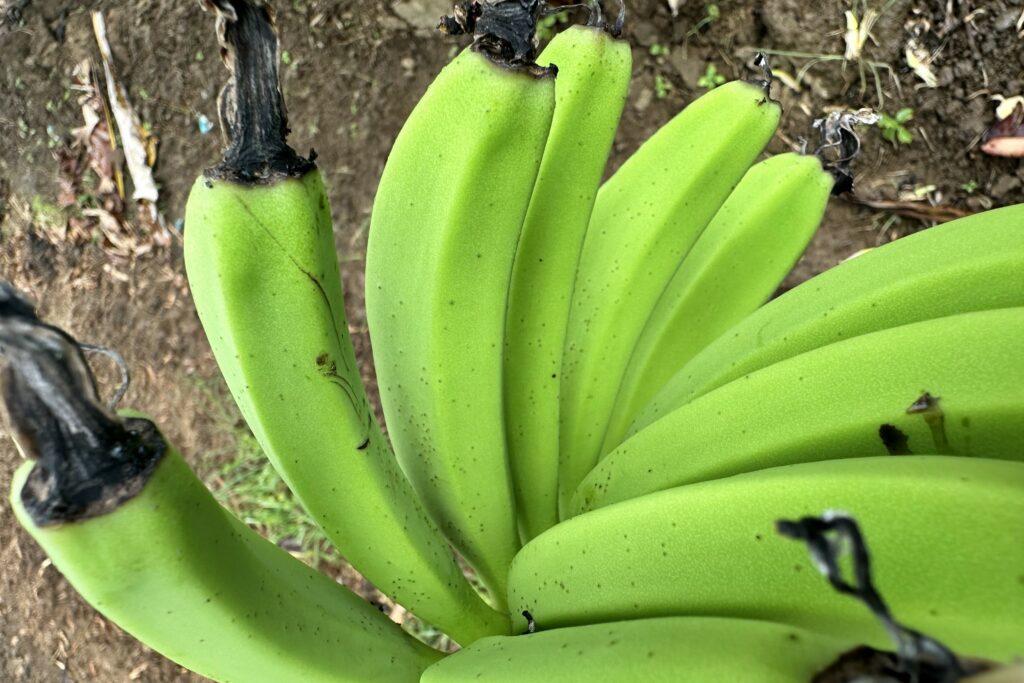Banana scab moth Nacoleia octasema
Posted on by Sarah Williams
Scab moth
The banana scab moth (Nacoleia octasema) is a significant threat to banana crops, with the potential to cause up to 100% damage to fruit if left uncontrolled. The larvae of this moth feed on emerging banana bunches, leading to cracking, scarring, and disfigurement of the fruit. Damage is usually confined to the outer curve of the fingers (the area nearest to the bunch stalk) but, in more severe cases, damage can extend to the stalk, areas between touching fingers, or even extend to cover the whole fruit surface. While the damage is usually superficial, severe cases can render the fruit unsuitable for the market.
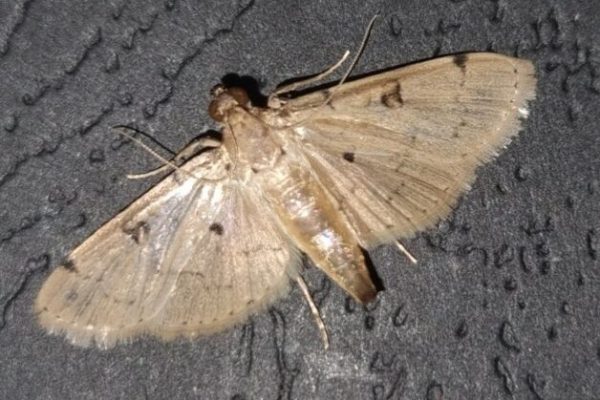
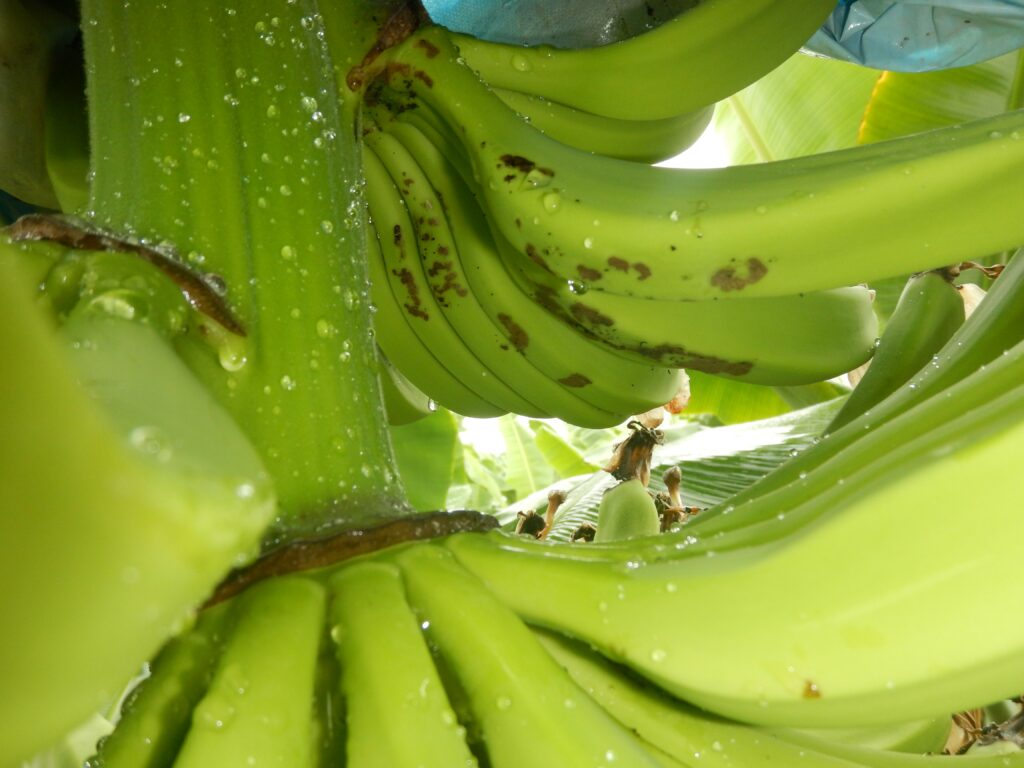

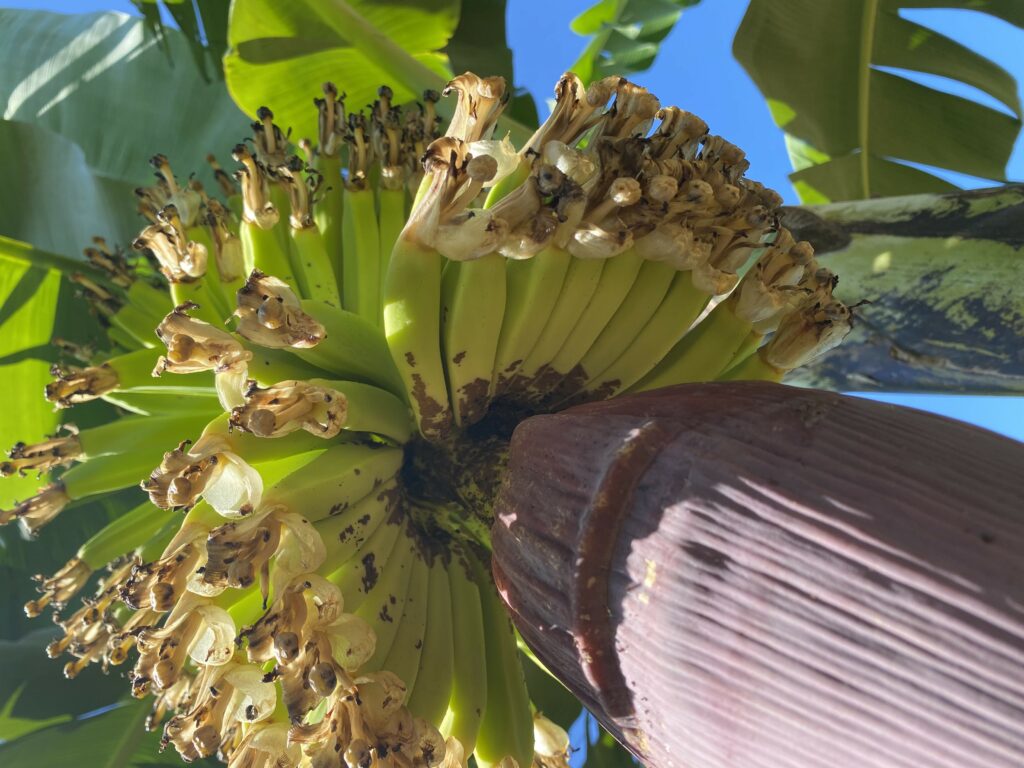
Banana scab moth is present throughout the year but is favoured by moist and warm conditions, hence the greatest potential for damage is during the wet season.
Being proactive and regularly checking bunches or getting feedback from baggers can help growers discover infestations before the fruit reaches the packing shed. Although damage can’t be undone, identifying, and addressing problems (re-training or integrating alternative control options) sooner can save other bunches from impact.
To manage infestations, year-round treatment is essential, most growers use chemical control through bell injection is recommended to prevent banana scab moth damage. Proactive monitoring and management are essential to minimize the impact of this pest on banana crops.
More information
This information has been prepared as part of the National Banana Development and Extension Program (BA19004) which is funded by Hort Innovation, using the banana industry research and development levies and contributions from the Australian Government. Hort Innovation is the grower-owned, not-for-profit research and development corporation for Australian horticulture. The Queensland Government has also co-funded the project through the Department of Agriculture and Fisheries.


Banana scab moth – monitoring and control
Posted on by Sarah Williams
Banana scab moth – Nacoleia octasema
Monitoring and control options
Monitoring
Being proactive and regularly checking bunches or getting feedback from baggers can help growers discover infestations before the fruit reaches the packing shed. Although damage can’t be undone, identifying, and addressing problems (retraining or integrating alternative control options) sooner can save other bunches from impact.
The method for monitoring for banana scab moth is to inspect freshly emerged bunches (bract fall) for the presence of damage and/or larvae. Pay attention to the underside of the fingers in each hand (closest to the bunch stalk) and the cushion area. In very young bunches, lifting the developing hand away from the bunch stalk may be necessary to reveal any larvae and/or fresh damage.
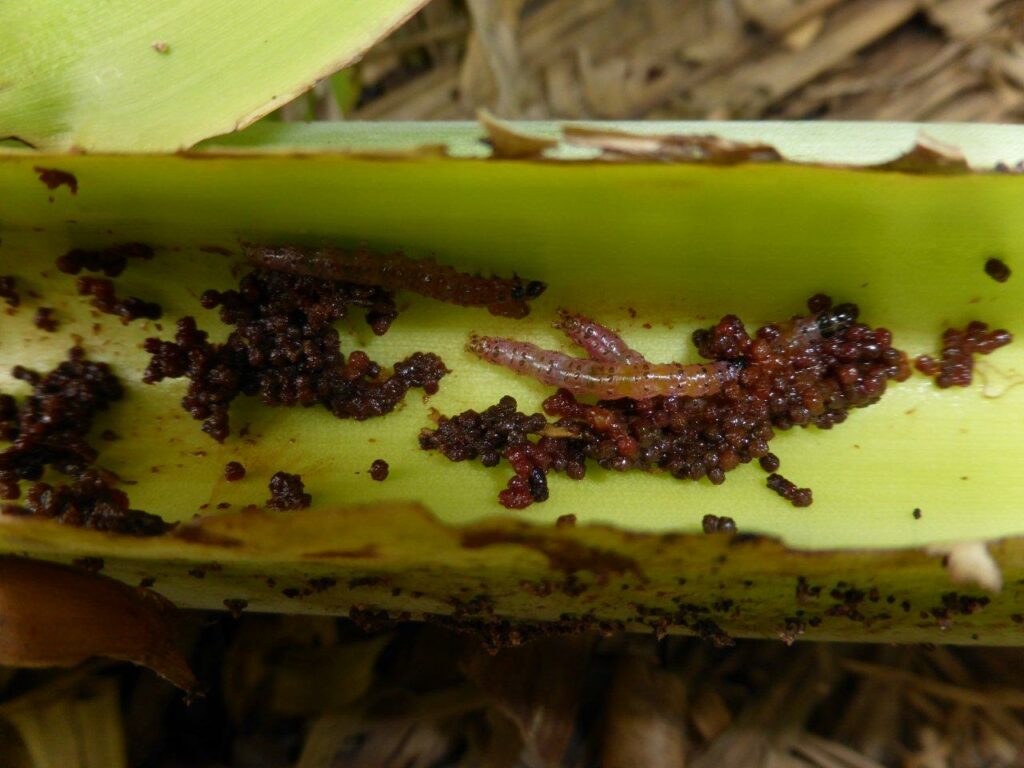
Also, examine the base of the bunch stalk where the larvae enter the throat of the plant. Larvae can be detected by separating the base of the flag leaf and removing the bract that is attached to the stalk. Often a clear jelly-like substance or frass feeding waste, which appears to be associated only with banana scab moth feeding in bananas, is present at these sites. Monitoring known ‘hot spots’ such as rows adjacent to scrub or creek lines is also a good idea. Banana scab moth has been documented to use Pandanus spp. and Heliconia spp. as alternative host plants.
Managing banana scab moth
Treatment for banana scab moth should be performed year-round as damage results in immediate downgrading or rejection of fruit. Management of banana scab moth is particularly important if heavy bunching is anticipated and/or the forecast weather conditions are favourable (hot and wet).
Biological control
Banana scab moth can be controlled by application of Bacillus thuringiensis subsp. Kurstaki based biopesticides (also known as B.T.) that will not adversely affect other beneficial insects. Some insects (parasitic flies and wasps, ants, spiders and other predators) feed on banana scab moth caterpillars and provide some level of control.
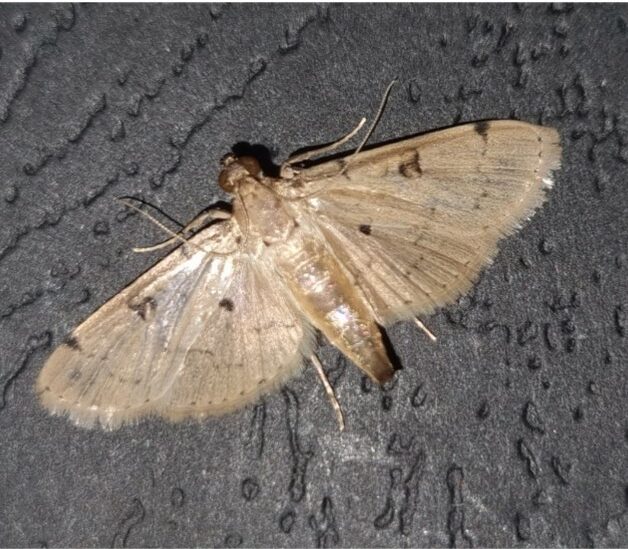
Cultural control
Selecting followers of equal size which equates to synchronised bunch emergence over a block will ensure that the application of chemical control methods is more efficient.
Chemical control
Bell injection is the preferred method of insecticide application to prevent banana scab moth damage. Bell injection is a targeted application of insecticide into the newly emerged bunch and the technique is unlikely to impact beneficial insects on other parts of the plant. The correct site for injection is approximately one third of the way down from the top of the upright, vertically positioned bell. Bells which are injected later than this (i.e., when horizontal) have an increased risk of insect damage.
Initial trial work completed by the Department of Agriculture and Fisheries (DAF) has also indicated that the volume of insecticide applied in bell injection is an important consideration. As insecticides require larger volumes to ensure good coverage, initial trial work showed that using 40mL volume wasn’t sufficient to get appropriate control at times of high pest pressure. It is recommended that growers use a 60mL volume at the specified label (or permit) rate for bell injection to provide adequate coverage.
Always check the APVMA website for current chemical registrations before use. Below are insecticides currently registered (August 2024) and permitted for bell injection to control banana scab moth.
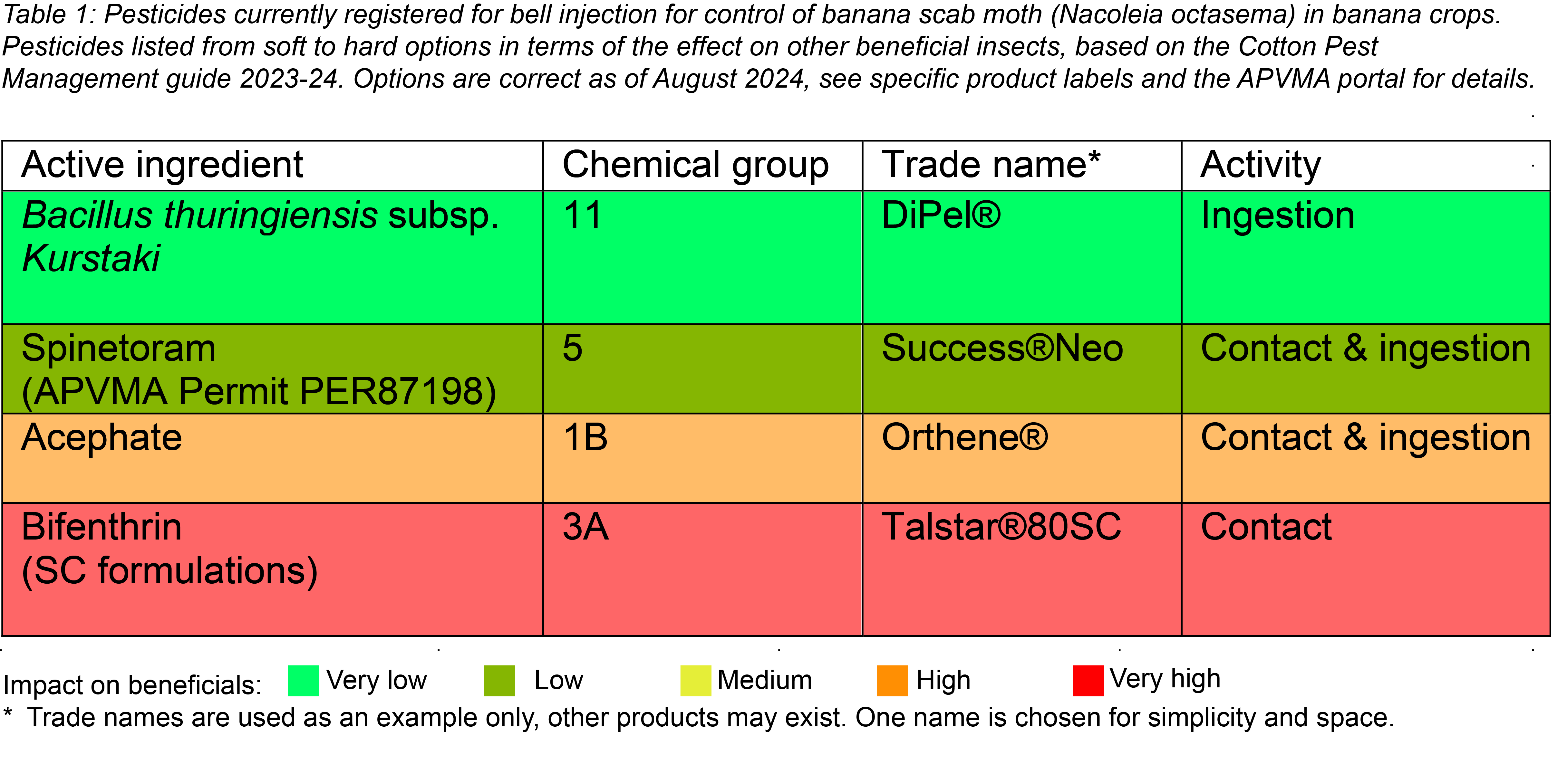
For more information contact:
The Better Bananas team
Department of Agriculture and Fisheries
South Johnstone
13 25 23 or email betterbananas@daf.qld.gov.au
This information is adapted from: Pinese, B., Piper. R 1994, Bananas insect and mite management, Department of Primary Industries, Queensland
This information has been updated as part of the National Banana Development and Extension Program (BA19004) which is funded by Hort Innovation, using the banana industry research and development levies and contributions from the Australian Government. Hort Innovation is the grower-owned, not-for-profit research and development corporation for Australian horticulture. The Queensland Government has also co-funded the project through the Department of Agriculture and Fisheries.


Banana Scab Moth – general information
Posted on by Sarah Williams
Banana scab moth Nacoleia octasema
General information
Occurrence
Banana scab moth is present throughout the year but is favoured by moist and warm conditions, hence the greatest potential for damage is during the wet season. Bunches that emerge from December through to the end of May are most at risk of severe fruit damage. The cooler and drier winter months are relatively free of banana scab moth damage. However, damage can occur if unseasonal rain occurs at this time. Research has shown adult moths do not mate or produce eggs under low humidity and dry conditions.
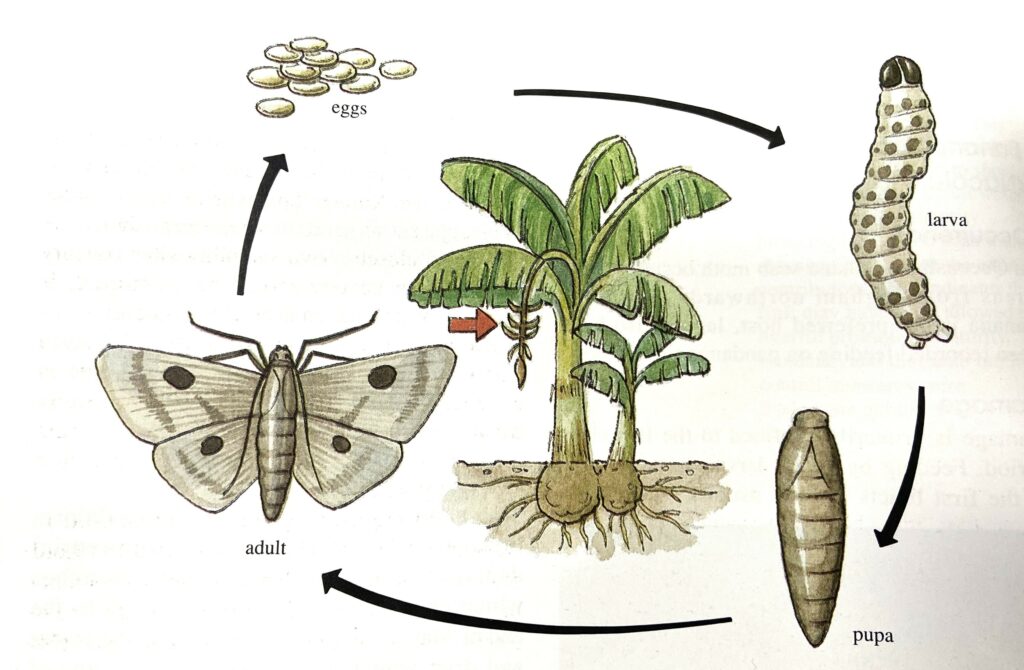
Description and lifecycle
The tiny (1.2-1.5mm) transparent or yellow flattened eggs are laid in clusters (of up to 30 eggs) that resemble miniature overlapping fish scales. These egg clusters are very difficult to locate because of their small size and the fact that they are laid near the throat of the plant. The eggs are usually laid on the emerging bunch and the surrounding leaves, but eggs have occasionally been found on the pseudostem below the new bunch. Larvae (caterpillars) are pink to brown in colour and range in length from 1.5mm when first hatched to about 25mm when fully developed. If disturbed the larvae wiggle violently and drop on silken threads to avoid predation. When larvae are fully mature they generally pupate in the trash at the base of plants or beneath dry leaf sheaths.
The adult moths are difficult to find due to their small size (22mm wingspan), the fact they hide during the day and their dull brown/grey colouration. Adults are most active at dusk when mating and egg laying occurs. Adults do not appear to be attracted to lights, unlike other moth species. The total lifecycle from egg to mature adult takes around 25-32 days.
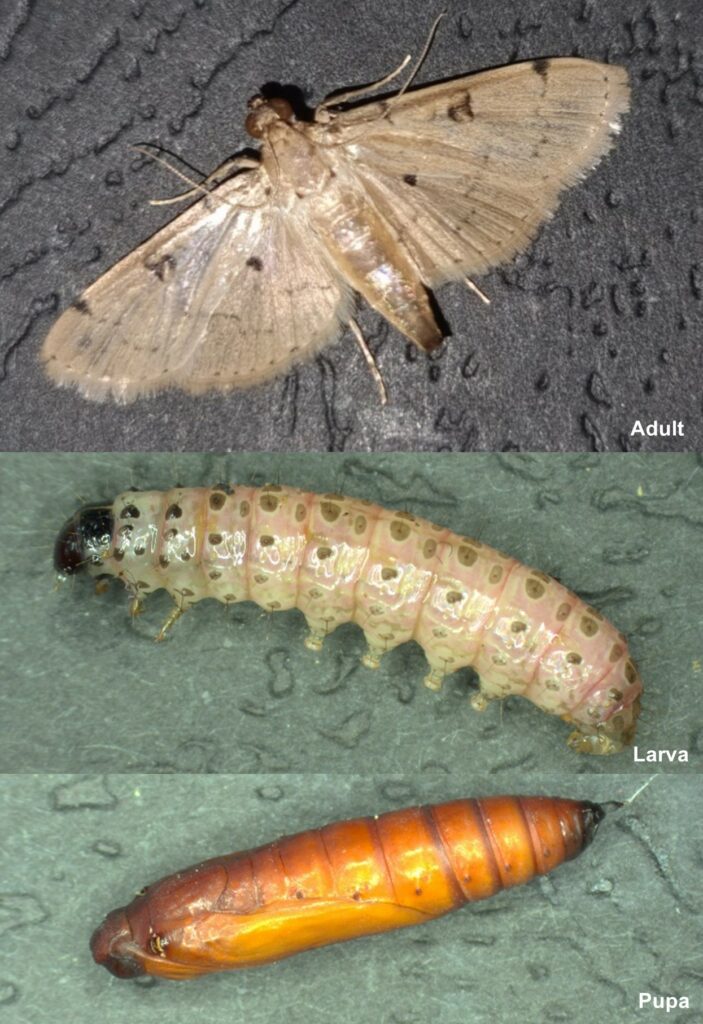
Damage
The banana scab moth is a severe pest of bananas and can cause up to 100% damage to the bunch if left uncontrolled.
Feeding by young larvae starts as soon as the first bracts lift and usually increases in severity as the larvae grow and move progressively down the bunch as subsequent bracts open. The feeding causes cracking and scarring to the fruit skin, while severe cases can cause disfigurement of fruit as the fingers enlarge. Damage is usually only superficial, where affected fruit is downgraded or deemed unsuitable for the market.
Damage is usually confined to the outer curve of the fingers (the area nearest to the bunch stalk) but, in more severe cases, damage can extend to the stalk, areas between touching fingers, or even extend to cover the whole fruit surface.
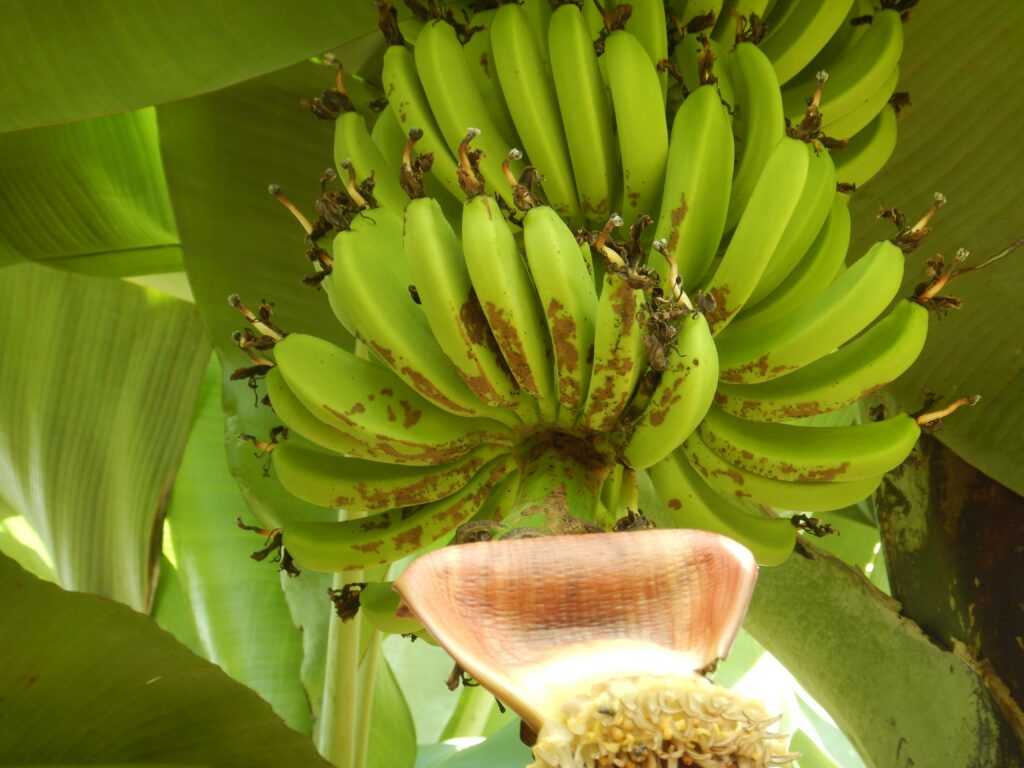



Larvae of banana scab moth also consume foliage and can damage plants where a bunch is absent. This leaf damage is worse in varieties such as Lady Finger and Ducasse and is generally not a problem in Cavendish.
For more information contact:
The Better Bananas team
Department of Agriculture and Fisheries
South Johnstone
13 25 23 or email betterbananas@daf.qld.gov.au
This information is adapted from: Pinese, B., Piper. R 1994, Bananas insect and mite management, Department of Primary Industries, Queensland
This information has been updated as part of the National Banana Development and Extension Program (BA19004) which is funded by Hort Innovation, using the banana industry research and development levies and contributions from the Australian Government. Hort Innovation is the grower-owned, not-for-profit research and development corporation for Australian horticulture. The Queensland Government has also co-funded the project through the Department of Agriculture and Fisheries.


Banana Weevil Borer mass trapping
Posted on by Sarah Williams
Banana weevil borer Mass trapping: A novel design, supporting long-lasting pheromone lures in NSW
Banana Weevil Borer (BWB) is one of the main issues for NSW banana growers. When BWB reach high numbers in the field, they significantly affect productivity by creating a network of tunnels in the corm. This tunnelling weakens the plant and increases the likelihood of blowdowns. BWB infestations affect nutrition uptake, contributing to slow growth, decreased bunch weights and overall poor plant health. NSW growers have successfully designed and implemented mass trapping approaches to deal with this issue, a technique proven to be effective in other countries. Mass trapping reduces pest numbers by luring them, with an attractant, in large numbers to a trap that either kills them or prevents their exit. In this article, we discuss NSW growers’ implementation of mass trapping systems and their successes. Growers who use mass trapping have found it an effective tool for monitoring and successful in reducing BWB pressure and plant damage.
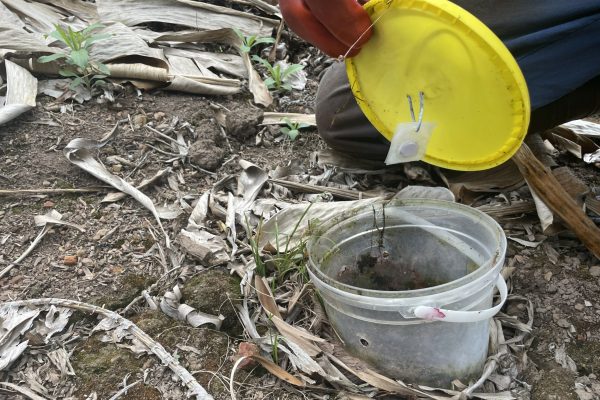
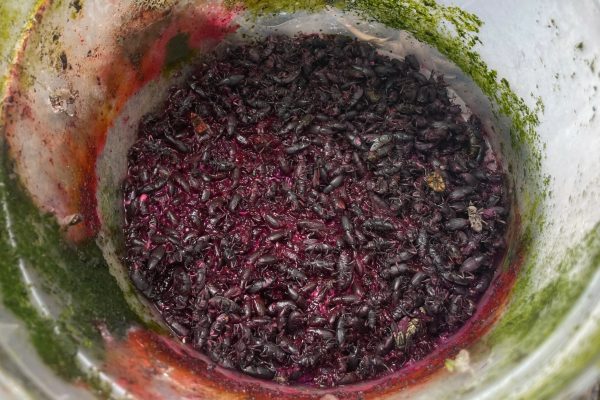
Background
In Australia, typically pseudostem discs or small pitfall traps (less than 500mL volume) are used for monitoring and, to a lesser degree, management of BWB. These strategies are effective in allowing growers to understand their BWB populations and their distribution across their farms. By comparison, international research, and growers, have designed larger pitfall traps (larger than 500mL volumes), to increase rates of BWB capture. These larger pitfall trap designs are possible through the long-lasting pheromone lures which can and historically have also been used domestically in small-scale traps and which can attract both male and female BWB from over 20m away in dry weather. According to an international study (Alpizar et al, 2012), using these large volume mass trapping pitfall traps (with the pheromone lures), at a density of 4 traps per hectare, was 5 to 10 times more effective than traps without pheromone. In this study, corm damage was reduced by half to two thirds after several months of use (from 20-30% corm tunnelling to 10% or less). The resulting reduction of corm damage was shown to increase bunch weights of Dwarf Cavendish (Musa acuminata Colla) by approximately 20%. Trials in Australian growing regions and prominent varieties are yet to be conducted and caution is needed before assuming similar performance outcomes could be attained.
Earlier research by NSW DPI investigated two types of long-lasting pheromone lures (effective for 90 days), to determine the most effective for the NSW region. While both lures are effective at attracting BWB, Cosmolure P160-lure 90 (C.sordidus) is preferred as it does not contain isoamyl acetate, which attracts native turkeys and domestic chickens that damage the traps. Growers who collaborated in the earlier pheromone investigation have continued trapping and over time have developing unique trapping systems using the longer-lasting pheromone.
Mass trapping pitfall design 1 (5L bucket trap)
One of the new innovative methods that growers have developed and implemented is the modified 5L bucket trap. NSW growers have modified a 5-litre bucket to make large volume, mass trapping pitfall traps. To make these traps firstly, several 10-millimetre holes are drilled into the side of the bucket. Next, the bucket is firmly established into the ground. It is important that the drilled holes are flush with ground level and soil ramps need to be made (simply pile soil up into a ramp so that BWBs would be able to walk into the hole and fall into the bucket). Once the trap is established in the hill side, the pheromone bait is set by hanging from the centre of the lid via a piece of wire.
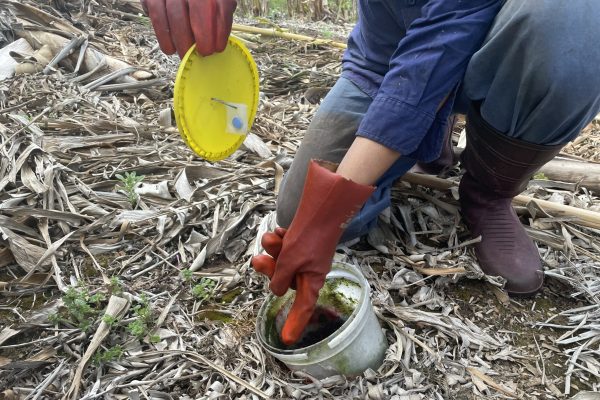
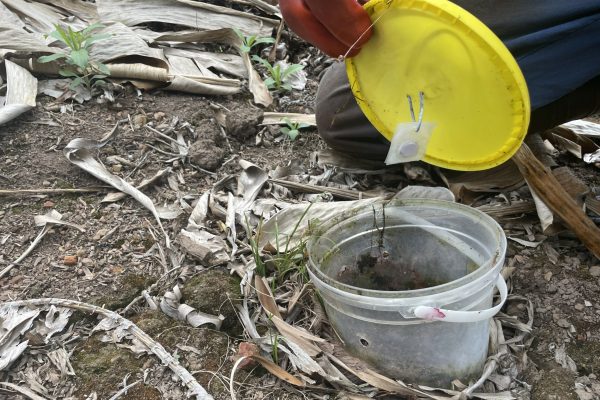
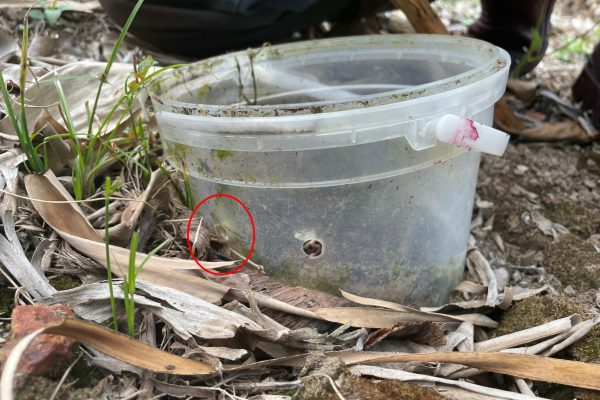
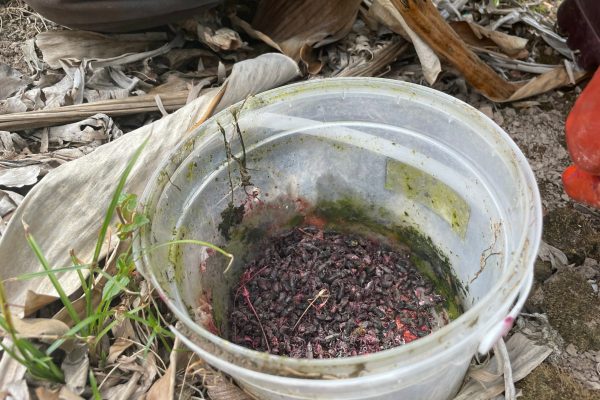
Mass trapping pitfall design 2 (PVC pipe trap)
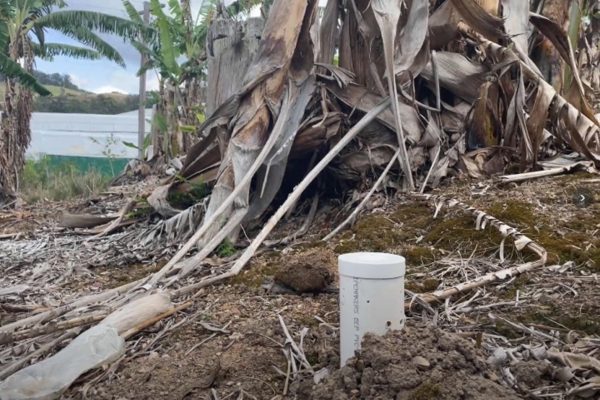
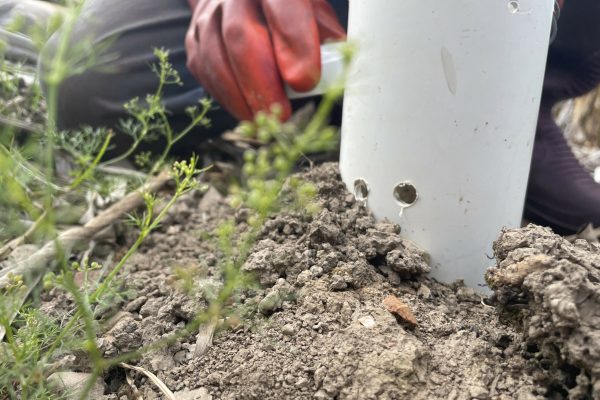

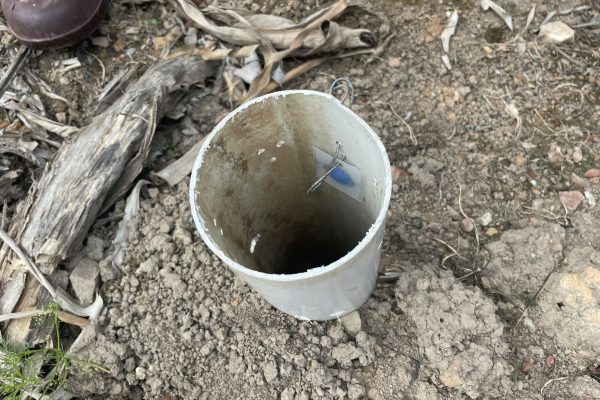
Another innovative design that NSW growers have adopted is a PVC pipe trap. This trap is made from PVC piping which creates a narrower but deeper trap, more stabilised into the hillside compared to the larger, shallower trap, shown in design 1. In this case, the dimensions are 100mm in diameter, and 500mm in length with the bottom of the trap made watertight with end caps and the top cap left loose to be able to take off. Similar to the pitfall trap there are drilled several holes, 10mm in size, where the trap meets the soil line to allow for BWB to enter. A wire is fixed into the lid or on the side, used to hold the pheromone lure in place. The grower used an auger to install the PVC pipe approximately 300 millimetres in depth into the soil.
“I decided to increase the size of the trap purely because the original (smaller pitfall) traps were filling up in a couple of days! After increasing the size of the traps, I now only need to revisit the trap every month for soil ramp maintenance and emptying. I’m more clued in, knowing where hot spots of densely populated BWB zones were located on their farm, and using this knowledge to inform decisions around when to apply chemical management options. Something that I didn't foresee is the increased peace of mind. Now, having the traps in the ground, I see it as a second line of defence, not just relying on chemical application to control BWB, especially within the hotter and wetter periods of the year."
-Coffs Harbour grower comments on using the 5L BWB bucket trap design
Trap maintenance and upkeep
The enlarged pitfall traps require low maintenance and only need to be checked on average once per month or after severe weather events. Emptying of dead BWB will fluctuate as BWB numbers and movements vary throughout the year. According to growers, ensuring the trap stays in place, and maintaining the soil ramps up to the trap are some of the key considerations to keep an eye on and it’s suggested to check these features more regularly.
It has been a suggestion to add soapy water to the bottom of pitfall traps to terminate BWBs once they are in the trap. Furthermore, the soap makes the walls of the trap slippery, preventing them from exiting the trap. However, growers have found that this may not be necessary when the walls of the trap are smooth, as the weevils find it hard to get traction to climb out of the traps.
Cost
The P160-Lure90, Cosomolure (C. sordidus) is approximately $11 per bait (tablet) and lasts 90 days. The current advised density is 4 traps per hectare with one pheromone bait in each trap, totalling 16 pheromone baits per hectare per year. Therefore, currently in 2024, the approximate cost is $175 per hectare, per year. This does not include the material for pitfall traps or labour costs to install and maintain them which needs to be considered. Prices will vary over time. Ensure getting quotes from relevant suppliers before implementation. For some growers, this is a relatively low cost per hectare to substantially reduce BWB numbers throughout a block in NSW. The continued pursuit of trapping innovations reflects the proactive approach NSW growers are taking in BWB management, offering a promising avenue for control. If you are interested in more information about BWB mass trapping contact Steven Norman (NSW DPI Industry Development officer) for assistance.
More information on Banana Weevil Borer:
References
Fu, B., Li, Q., Qiu, H., Tang, L., Zhang, X., & Liu, K. (2019). Evaluation of different trapping systems for the banana weevils Cosmopolites sordidus and Odoiporus longicollis. International Journal of Tropical Insect Science, 39, 35-43
Alpizar, D., Fallas, M., Oehlschlager, A. C., & Gonzalez, L. M. (2012). Management of Cosmopolites sordidus and Metamasius hemipterus in banana by pheromone-based mass trapping. Journal of chemical ecology, 38, 245-252.
This information has been produced as part of the National Banana Development and Extension Program (BA19004). This project has been funded by Hort Innovation, using the banana research and development levy with co-investment from the Queensland Department of Agriculture and Fisheries, New South Wales Department of Primary Industries and contributions from the Australian Government. Hort Innovation is the grower-owned, not-for-profit research and development corporation for Australian horticulture.


Spider mites summary
Posted on by Sarah Williams
Spider mites
The banana spider mite (Tetranychus lambi) and the two-spotted mite (Tetranychus urticae) which are both commonly referred to as ‘spider mites’ or ‘red spider’, can cause significant damage to banana leaves and even fruit when present at high levels. They are a common pest of bananas, especially over the warmer spring and summer months. Mites feed mainly on the underside of plant leaves, consuming the contents of plant cells. This permanently damages the leaf and reduces its functionality. With moderate to severe mite damage, fruit development can be delayed and occasionally fruit can be marked with a reddish discolouration towards the cushion end.
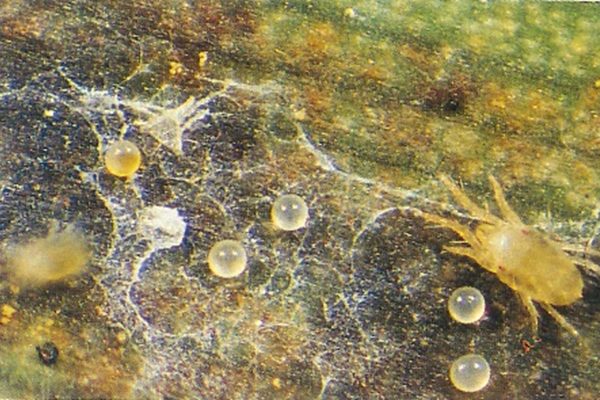
Early detection and the adoption of practices to help minimise spider mite populations will greatly assist in managing this pest. Click below for more information on management options.
More information
This information has been updated as part of the National Banana Development and Extension Program (BA19004) which is funded by Hort Innovation, using the banana industry research and development levies and contributions from the Australian Government. Hort Innovation is the grower-owned, not-for-profit research and development corporation for Australian horticulture. The Queensland Government has also co-funded the project through the Department of Agriculture and Fisheries.



